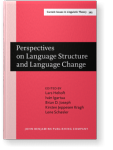Table of contents
Perspectives on language structure and language change: An introduction
Part I.On the theory of language change
Andersen (1973) and dichotomies of change
Induction and Tradition. “As time goes by…” – Play it again!
Approaching the typology and diachrony of morphological reversals
Deconstructing markedness in sound change typology: Notes on θ > f and f > θ
Part II.Indexicality
Diachronic morphology, indexical function and a critique of the morphome analysis: The content and expression of Danish forstå
Word order as grammaticalised semiotic systems
Part III.Problems of reanalysis
Anticausative and passive in Vedic: Which way reanalysis?
Grammaticalization and degrammati(calizati)on in the development of the Iranian verb system
Aspects of grammaticalization and reanalysis in the voice domain in the transition from Latin to early Italo-Romance
Aspects of grammaticalization and reanalysis in the voice domain in the transition from Latin to early Italo-Romance
Reanalysis in the Russian Past Tense: The Gerundial Perfect
From a single lexical unit to multiple grammatical paradigms
Morphosyntactic reanalysis in Australian languages: Three studies
Definiteness in Germanic and Balto-Slavic historical and comparative perspectives
Part IV.Actualization
Diatopy and frequency as indicators of spread: Accentuation in Bulgarian dialects
Diatopy and frequency as indicators of spread: Accentuation in Bulgarian dialects
Part V.Language change and diachronic typology in Balto-Slavic
A complicated relationship Balto-Slavic accentual mobility as a non-trivial shared innovation
“Name-calling: The Russian ‘new vocative’ and its status”
Changes of tense and modality in Late Medieval SloveneTransference, extension or both?
Index
This article is available free of charge.
